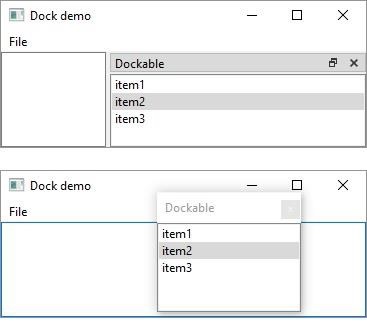
- PyQt5 - Home
- PyQt5 - Introduction
- PyQt5 - What’s New
- PyQt5 - Hello World
- PyQt5 - Major Classes
- PyQt5 - Using Qt Designer
- PyQt5 - Signals & Slots
- PyQt5 - Layout Management
- PyQt5 - Basic Widgets
- PyQt5 - QDialog Class
- PyQt5 - QMessageBox
- PyQt5 - Multiple Document Interface
- PyQt5 - Drag & Drop
- PyQt5 - Database Handling
- PyQt5 - Drawing API
- PyQt5 - BrushStyle Constants
- PyQt5 - QClipboard
- PyQt5 - QPixmap Class
- PyQt5 Useful Resources
- PyQt5 - Quick Guide
- PyQt5 - Useful Resources
- PyQt5 - Discussion
PyQt5 - QDock Widget
A dockable window is a subwindow that can remain in floating state or can be attached to the main window at a specified position. Main window object of QMainWindow class has an area reserved for dockable windows. This area is around the central widget.
A dock window can be moved inside the main window, or they can be undocked to be moved into a new area by the user. These properties are controlled by the following QDockWidget class methods −
| Sr.No. | Methods & Description | |||||
|---|---|---|---|---|---|---|
| 1 |
setWidget() Sets any QWidget in the dock windows area |
|||||
| 2 |
setFloating() If set to true, the dock window can float |
|||||
| 3 |
setAllowedAreas() Sets the areas to which the window can be docked
|
|||||
| 4 |
setFeatures() Sets the features of dock window
|
Example
In the following example, top level window is a QMainWindow object. A QTextEdit object is its central widget.
self.setCentralWidget(QTextEdit())
A dockable window is first created.
self.items = QDockWidget("Dockable", self)
A QListWidget object is added as a dock window.
self.listWidget = QListWidget()
self.listWidget.addItem("item1")
self.listWidget.addItem("item2")
self.listWidget.addItem("item3")
self.items.setWidget(self.listWidget)
Dockable object is placed towards the right side of the central widget.
self.addDockWidget(Qt.RightDockWidgetArea, self.items)
The complete code is as follows −
import sys
from PyQt5.QtCore import *
from PyQt5.QtGui import *
from PyQt5.QtWidgets import *
class dockdemo(QMainWindow):
def __init__(self, parent = None):
super(dockdemo, self).__init__(parent)
layout = QHBoxLayout()
bar = self.menuBar()
file = bar.addMenu("File")
file.addAction("New")
file.addAction("save")
file.addAction("quit")
self.items = QDockWidget("Dockable", self)
self.listWidget = QListWidget()
self.listWidget.addItem("item1")
self.listWidget.addItem("item2")
self.listWidget.addItem("item3")
self.items.setWidget(self.listWidget)
self.items.setFloating(False)
self.setCentralWidget(QTextEdit())
self.addDockWidget(Qt.RightDockWidgetArea, self.items)
self.setLayout(layout)
self.setWindowTitle("Dock demo")
def main():
app = QApplication(sys.argv)
ex = dockdemo()
ex.show()
sys.exit(app.exec_())
if __name__ == '__main__':
main()
The above code produces the following output. Click on Dock icon to undock the ListWidget window. Double click to dock again −
